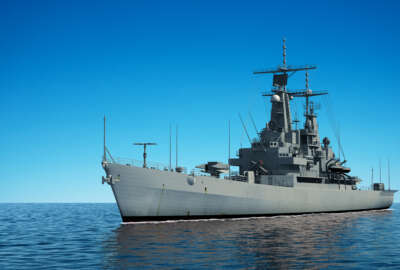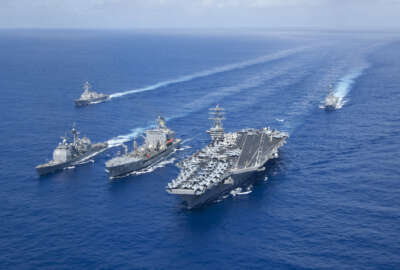
Navy to deploy unmanned vessels, AI in region where it’s struggled to meet demand for ships
The Navy's expansion of unmanned systems follows experimentation work it's been conducting in the Middle East, where it's combined drones with sensors connected...
The Navy says it’s having trouble meeting its homeland defense responsibilities in the Carribbean and other areas of U.S. Southern Command. That’s one of several reasons officials think that region — the 4th Fleet, in Navy parlance — is an ideal place to continue proving out the feasibility of unmanned ships, aided by advanced technologies like artificial intelligence.
The plans, announced Tuesday, are an expansion of the unmanned experimentation work the Navy has been doing in its 5th Fleet, which covers waters in the Middle East. There, the Navy’s Task Force 59 has been working on integrating unmanned systems with a mesh network made up of advanced sensors that can collect and transmit data even when enemy forces are trying to jam traditional communications networks.
Carlos Del Toro, the secretary of the Navy, said the 4th Fleet expansion will help inform the service’s eventual transition to a “hybrid” fleet of manned and unmanned ships around the world.
“It provides us with an environment best suited to operationalize the concepts Task Force 59 has worked tirelessly to develop so that we can increase our maritime domain awareness (MDA) capabilities,” he told attendees at the annual Sea Air Space conference in National Harbor, Md. “The MDA technologies and platforms we are bringing to the region will address several significant challenges. These include narcotics and human trafficking, as well as economic and ecological harm caused by illegal, unreported and unregulated fishing, which the People’s Republic of China participates in through their distant water fishing fleets. The sustained presence of these unmanned platforms provide us with the endurance and reach necessary to complement the activities of our manned platforms, freeing them up for other missions.”
Del Toro said the Navy plans to move “fairly quickly” to implement unmanned systems in Southern Command (SOUTHCOM). The “kickoff,” he said, will be in July during this year’s annual UNITAS event, a multinational training exercise with navies from Central and South America.
The Navy has struggled in recent years to meet requests for forces from Southern Command (SOUTHCOM) and the Joint Interagency Task Force-South (JIATF-South), a DoD-DHS task force that focuses on counternarcotics missions.
According to the Government Accountability Office, the problem was most acute in 2013, when the Budget Control Act imposed sudden spending cuts that forced JIATF to sit and watch as known drug shipments passed through the waters it’s charged with monitoring. But the problem hasn’t abated much since then, according to a deployment tracker maintained by the U.S. Naval Institute. As of this month, out of a battle force of 296 ships, the Navy only had one vessel deployed to SOUTHCOM, and the number has stayed in the low-single digits for at least the past year, according to USNI’s data.
“We think we have a responsibility to defend and to watch over the maritime approaches to North America, and arguably right now, given the size of the fleet we have and the global responsibilities that we must attend to, we think unmanned takes it to another level,” said Adm. Michael Gilday, the chief of naval operations. “In that area of responsibility, we’ll be able to keep more of an unblinking eye on that traffic coming north.”
But Gilday said the 4th Fleet and SOUTHCOM are also a good fit for the advanced technologies the Navy is looking to deploy as part of Project Overmatch, the service’s contribution to DoD’s Joint All-Domain Command and Control (JADC-2) project.
Those data-intensive efforts are meant to make better use of DoD’s data and connect its sensors and weapons systems together into one interoperable framework. And JIATF-South isn’t lacking for data.
“There’s a lot of intelligence that already feeds into JIATF-South, so we think that we can leverage machine learning and artificial intelligence capabilities with that information,” Gilday said. “That will be supplemented by the data that we pull in from unmanned platforms to give us a much better common operational picture. And perhaps leveraging AI will let us be much more predictive in terms of where that traffic is coming from, and be much more effective in terms of intercepting it.”
For at least the immediately foreseeable future, none of the new ships will be autonomous. For now, they’ll be remotely-operated or “minimally-manned,” but officials think AI technologies are likely to eventually get the Navy to the point of fully-autonomous operations.
Gilday said the Navy’s initial experiments look promising.
“On our large surface unmanned vessels as an example, we have 50,000-plus nautical miles of transit in an autonomous mode, and we have a high degree of confidence in the AI’s ability to follow navigation rules, avoid traffic and to stay within the channel when required,” he said. “We made transits from the Gulf Coast of the United States repeatedly through the Panama Canal, and up around to Port Hueneme, California. But it takes it to another whole level when you give a vessel a mission and then have that vessel report back ‘mission complete.’ So this is going to be an iterative process. We see these vessels deploying with carrier strike groups rather than just out there operating beyond line of sight autonomously. We need to go slow to go fast — it has to be very deliberate, with a great deal of respect for AI and the fact that we still we still have a lot to learn.”
Copyright © 2024 Federal News Network. All rights reserved. This website is not intended for users located within the European Economic Area.
Jared Serbu is deputy editor of Federal News Network and reports on the Defense Department’s contracting, legislative, workforce and IT issues.
Follow @jserbuWFED
Related Stories





